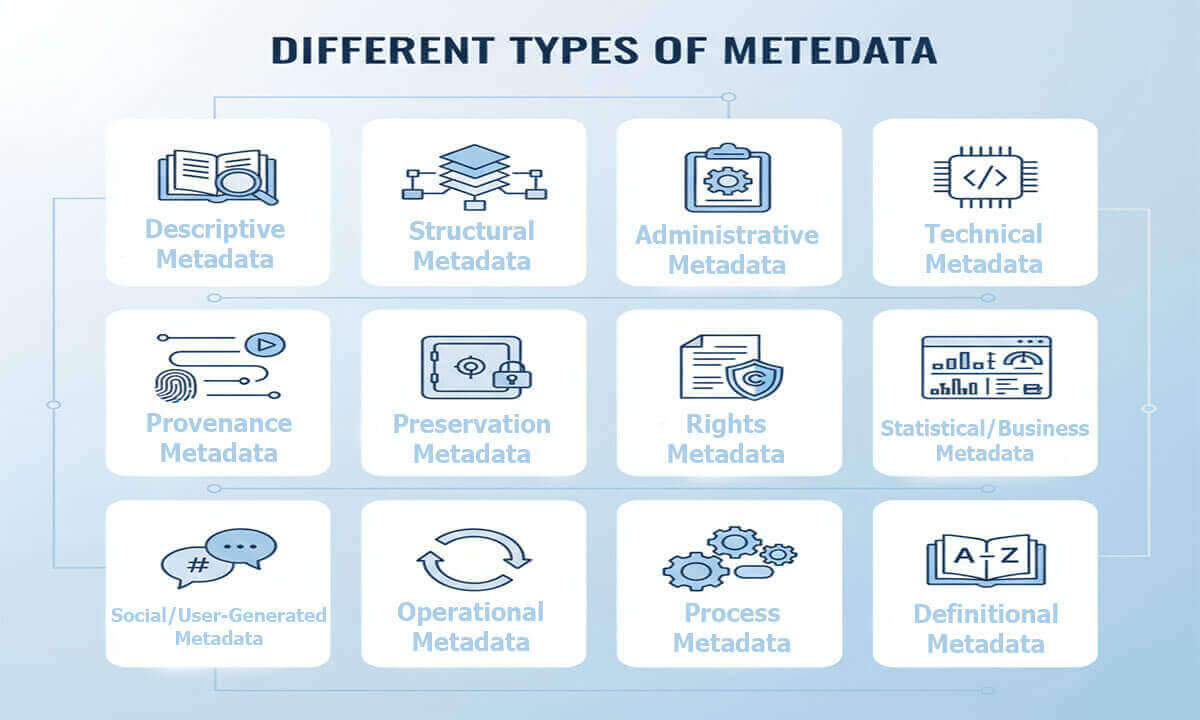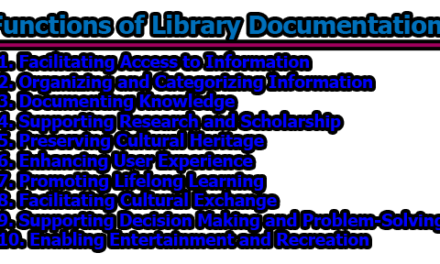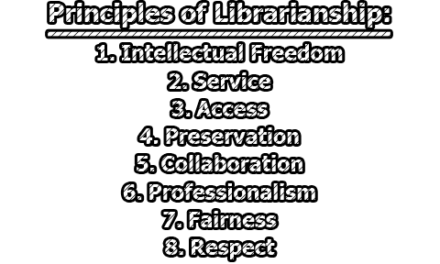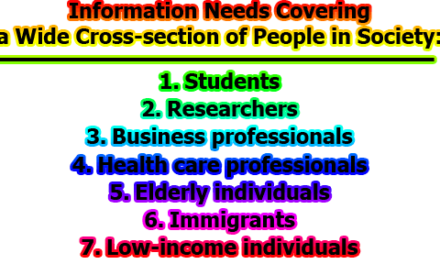Different Types of Metadata:
In today’s world, we create and use huge amounts of data every single day—when we read books online, share photos, watch videos, or search for information. But data on its own can be confusing or meaningless without some form of explanation. This is where metadata becomes very important. Metadata simply means “data about data.” It gives useful details about a file or resource, such as who created it, when it was made, what it is about, and how it can be used. In other words, metadata helps us understand, organize, and find information more easily. Different types of metadata serve different purposes. Some types describe what the data is about, some explain how it is structured, and others tell us who owns it or how to keep it safe for the future. Together, these types of metadata make information systems more reliable, organized, and user-friendly. Whether in libraries, businesses, research, or online platforms, metadata plays a key role in keeping our digital world connected and meaningful.
1. Descriptive Metadata: Descriptive metadata is the type of information that helps people find and identify a data resource. It tells you what the data is about. Think of it like a label or a summary on a library book—it includes things like the title, author, subject, keywords, and short description.
For example, when you search for a movie on Netflix or a song on Spotify, the results show you details such as the title, year of release, genre, and artist. All those details are descriptive metadata. They help users discover the right movie or song quickly.
In libraries, descriptive metadata allows users to search by author name, topic, or title. In digital databases or websites, it makes it easier for search engines like Google to display relevant results.
In short, descriptive metadata answers the question: “What is this item, and how can I find it?”
2. Structural Metadata: Structural metadata explains how data is organized and how different parts of a digital resource are connected to each other. It focuses on the structure rather than the content itself.
For example, think of an e-book. Structural metadata shows how the chapters, sections, and pages are arranged, so when you click “Next Chapter,” the system knows where to take you. In a website, it might describe how different web pages link together. In multimedia, it could show how video, audio, and subtitles are synchronized to play properly.
Without structural metadata, digital systems would have a hard time showing the right order or relationships between parts of a file. It helps computers understand how to assemble or navigate a digital item, making sure users can experience it correctly.
So, structural metadata basically answers: “How is this resource put together?”
3. Administrative Metadata: Administrative metadata is all about managing a data resource behind the scenes. It gives information about how and when something was created, who can use it, and what technical settings are needed to keep it safe or working.
For example, a digital photo might have administrative metadata that includes the date it was taken, the camera model used, and who owns the rights to it. A document in an organization’s database might show who uploaded it, when it was last updated, and what level of access other employees have (e.g., read-only or editable).
This type of metadata is especially useful for librarians, archivists, and IT staff who manage and preserve data. It helps track ownership, version control, and usage permissions. Administrative metadata ensures that digital files are properly maintained and that only authorized people can make changes.
In simple terms, administrative metadata answers: “Who manages this data, and how should it be handled?”
4. Technical Metadata: Technical metadata gives information about the technical details of a digital file. It describes how the file was created, what format it’s in, and what tools or software are needed to use it. This helps computers and people understand how to open, view, or process the file correctly.
For example, a photo file may include information like its format (JPEG or PNG), resolution, color depth, and the camera settings used (such as ISO or shutter speed). For a video, it might include the frame rate, video codec, and file size. In a dataset, technical metadata can describe the software version or data model used to create the file.
This information is very important in technology and digital preservation because it ensures that files can still be opened and used even after many years. Without technical metadata, digital items might become unreadable if the original software or devices are no longer available.
In simple words, technical metadata answers the question: “What are the technical details needed to use or preserve this file?”
5. Provenance Metadata: Provenance metadata is about the history and origin of a piece of data. It keeps track of where the data came from, who created it, and what changes have been made over time. Think of it like a record of ownership and activity—a digital “biography” of the data.
For example, in scientific research, provenance metadata records how data was collected, what instruments were used, who analyzed it, and what methods were applied. In business or government documents, it shows who created, approved, or edited the file. This makes it easier to trust the data because users can see its full background.
Provenance metadata is also useful for detecting errors or manipulation. If something in a dataset looks suspicious, the provenance record can show who last modified it and when. It’s essential for transparency and accountability in research, law, and digital management.
In short, provenance metadata answers: “Where did this data come from, and what has happened to it since then?”
6. Operational Metadata: Operational metadata describes how data is used, processed, and managed in daily operations. It focuses on the actions performed on data—such as how it is collected, transformed, moved, or updated within systems. This type of metadata is especially important in large organizations, data warehouses, and business intelligence systems, where data flows through many stages and tools.
For example, in a company’s data system, operational metadata might record when a dataset was last refreshed, how often it is backed up, or what processes are used to clean or combine it. In simpler terms, it tells you how data behaves during its life cycle. If a database is automatically updated every night, operational metadata keeps track of that schedule and any issues that occur.
Operational metadata is valuable because it helps data managers monitor performance, troubleshoot problems, and improve efficiency. It can show whether a system ran smoothly or if there were delays, errors, or failed updates. In modern data analytics, this type of metadata supports automation, quality control, and transparency.
In short, operational metadata answers the question: “What happens to this data during everyday use, and how is it managed?”
7. Process Metadata: Process metadata provides information about the processes or steps involved in creating, transforming, or analyzing data. It focuses on the how—how data was produced, what tools or methods were used, and what stages it went through before reaching its final form. This type of metadata is essential for understanding the workflow behind data generation and ensuring that the results are trustworthy and reproducible.
For example, in scientific research, process metadata might describe the steps taken to clean and prepare data, the statistical methods used for analysis, or the software tools involved. In a business setting, it could record how sales data is aggregated from different branches or how financial reports are generated each month.
Process metadata helps users trace and understand the logic behind the data. It also supports transparency and accountability—anyone reviewing the data can see exactly how it was handled or transformed. This makes it easier to detect errors, repeat experiments, or update workflows in the future.
In simple terms, process metadata answers the question: “What steps were taken to create or modify this data?”
8. Preservation Metadata: Preservation metadata helps ensure that digital files remain usable and accessible over a long period of time. It records information that supports digital preservation—how files are stored, maintained, and updated as technology changes.
For example, imagine an old video stored on a CD. Over time, the CD may become unreadable, so archivists might transfer the video to a newer format or cloud storage. Preservation metadata keeps a record of that process—it notes the migration date, new format, and checksums (digital fingerprints used to verify that the file hasn’t been corrupted).
Libraries, museums, and archives use preservation metadata to protect cultural heritage and historical records. It ensures that digital information will still be readable and authentic decades from now, even if the technology we use today disappears.
Simply put, preservation metadata answers: “How can we keep this data safe and usable in the future?”
9. Rights Metadata: Rights metadata deals with the ownership and usage rights of a digital resource. It explains who owns the item, who can use it, and under what conditions. This type of metadata is important for protecting intellectual property and avoiding copyright violations.
For example, a photo uploaded online might include rights metadata that says “© John Smith, 2024 – All rights reserved.” It may also specify whether others can download or reuse the image. In libraries or digital archives, rights metadata tells users whether a document is open access (free to use) or if they need permission to view or share it.
In businesses, rights metadata ensures that employees know which materials are licensed or confidential. It helps organizations stay legally compliant and avoid misuse of protected data.
In simple terms, rights metadata answers: “Who owns this data, and what can others do with it?”
10. Statistical or Business Metadata: Statistical or business metadata is mainly used in companies, government agencies, and research organizations. It gives background information about how data was collected, what it means, and how it should be used in analysis or decision-making.
For example, in a company’s sales database, business metadata might define what counts as a “sale,” how discounts are recorded, or what time zone the data uses. In national statistics offices, it might explain how unemployment rates are measured or what sample size was used in a survey.
This kind of metadata makes sure that everyone interprets the data the same way. It reduces confusion, ensures accuracy, and improves communication between departments. It’s especially useful for data analysts and decision-makers who rely on consistent definitions and methods.
Simply put, statistical or business metadata answers: “What does this data mean, and how was it created or measured?”
11. Social or User-Generated Metadata: Social or user-generated metadata comes from the users themselves, rather than from professionals or systems. It includes things like tags, ratings, comments, and reviews that people add to online content.
For example, when you “tag” a friend in a photo on social media or add hashtags like #travel or #food to a post, you’re creating user-generated metadata. Similarly, when users rate a product on Amazon or comment on a YouTube video, their input helps categorize and describe that content for others.
This type of metadata makes digital systems more interactive and community-driven. It helps others find relevant information based on real user behavior and preferences. However, because it’s created by many people, it can sometimes be inconsistent or subjective.
In short, user-generated metadata answers: “What do users think or say about this content?”
12. Definitional Metadata: Definitional metadata provides clear meanings and explanations of the data elements used within a system. It defines what each data item represents, what units or formats it uses, and how it should be interpreted. This type of metadata ensures that everyone who uses the data understands it in the same way, avoiding confusion and misinterpretation.
For example, in a university database, definitional metadata might explain that the field “GPA” stands for Grade Point Average and is measured on a scale from 0 to 4.0. In a business context, it might define terms like “Customer,” “Revenue,” or “Transaction Date” so that every department uses consistent meanings.
Definitional metadata is especially valuable when different systems or teams share information. Without it, data may be misunderstood or misused—for instance, one system might record “sales” as confirmed orders, while another includes pending ones. By setting clear definitions, organizations ensure consistency, quality, and accurate analysis.
In simple terms, definitional metadata answers the question: “What does this data mean?”
In conclusion, metadata may not always be visible, but it plays a powerful role in how we use and understand information. It gives structure to raw data, making it easier to search, share, and preserve. Each type of metadata—such as descriptive, structural, administrative, technical, provenance, preservation, rights, business, and user-generated—has its own purpose and value. Through metadata, we can find information faster, ensure that digital files remain safe and usable, and protect the rights of creators. It also helps build trust in data by showing where it came from and how it has been used. As the world becomes more digital every day, knowing how metadata works helps us manage information wisely and use it to make better decisions. In simple terms, metadata turns plain data into meaningful knowledge.

Library Lecturer at Nurul Amin Degree College










